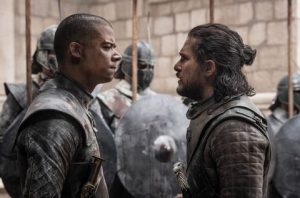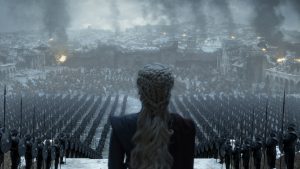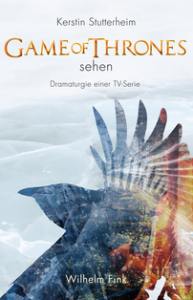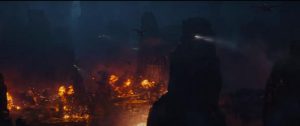In wenigen Tagen beginnt die neue Staffel von GAME OF THRONES, von vielen Fans lange erwartet. Am selben Tag wird ‚Game of Thrones sehen – Dramaturgie einer TV Serie‘ ausgeliefert. Hier ein urheberrechtlich geschützter Auszug:
https://www.fink.de/katalog/titel/978-3-7705-6204-6.html?tx_mbooks%5Badded%5D=1&cHash=11d6084d2bda7b5e0d15d9eac49766ef
Vorspann
Game of Thrones sehen, bedeutet für viele Menschen Vergnügen und Herausforderung zugleich, für andere eine Zumutung oder Grund zur kritischen Auseinandersetzung. Die Serie zu schauen, mag unterschiedliche Anlässe haben und die Art und Weise, diese zu sehen, sehr verschieden sein.
Die Serie mag für ein breites Publikum attraktiv sein, weil sie sich über die Ästhetik der Inszenierung von anderen Produktionen absetzt. Produziert ist sie als großes Kino fürs Fernsehen. Und dass die Handlung durchaus Bezüge zum Zeitgeist, zu unserer Erfahrung von Gegenwart hat, spricht ebenfalls ein Publikum an. Über die Ästhetik der Serie wird nicht nur eine Illusion eines fantastischen Frühers[1] hergestellt, sondern eine Metapher erzählt. Die große Vielfalt der gut gearbeiteten Charaktere mag ebenfalls dazu beitragen, dass die Serie so viele Menschen anspricht.
In dem vorliegenden Buch wende ich mich einigen Aspekten der Serie zu, zu denen mir in den zurückliegenden Jahren immer wieder Fragen gestellt wurden oder die dramaturgisch interessant sind und vielleicht eine neue Sicht auf die Serie eröffnen. Der vorliegende Text beruht auf meinem dramaturgischen Interesse an der Serie, die aus eben dieser dramaturgischen Sicht handwerklich und künstlerisch außergewöhnlich gut gemacht ist.
Dramaturgie – die in einem der ersten Kapitel kurz erläutert wird – ist eine Tradition des Wissens um Praktiken und künstlerische Prozesse, die sich dem gesamten Werk zuwendet[2]; nicht nur dem Text, dem Drehbuch, den Dialogen. Ästhetik und Dramaturgie sind philosophische Disziplinen. Dramaturgie ist eine praxisbezogene Wissenschaft und eine wissensbasierte Praxis, die sich über mehrere Jahrhunderte herausgebildet hat und so einen eigenen Berufsstand bezeichnet – den am wenigsten bekannten im Bereich des Films und der darstellenden Künste.
Die Frage, die sich mir wie Studierenden und Filminteressierten stellt, ist die danach, warum ausgerechnet diese Serie weltweit so erfolgreich ist. Und damit verbunden ist die Frage danach, wie sie gemacht wurde. Warum trotz aller – vermeintlicher – Überraschungen oder – scheinbaren – Irreführungen die Serie ihr Publikum fesselt. Dazu gehören Aspekte wie diese: Wie ist es möglich, eine Figur einzuführen und das Publikum einzuladen, zu diesem Charakter Sympathie zu entwickeln, und diese kurz darauf zu Tode kommen lassen – und dennoch schaut das Publikum fasziniert weiter? Es wird ein großes und stetig wachsendes Ensemble an Figuren über verwobene Erzählstränge über mehrere Regionen geführt – und die Zuschauer_innen fühlen sich nicht überfordert, gehen immer weiter mit. Das widerspricht allen – sich allerdings erst in den letzten Jahrzehnten eingeschriebenen – vermeintlichen Grundregeln des Schreibens und Produzierens fürs Fernsehen und ist dennoch erfolgreich. Meiner Meinung nach nutzen die Autor_innen und Regisseure die Möglichkeiten und Traditionen der Dramaturgie der darstellenden Künste hier sehr bewusst. Sie widersprechen diesen nicht, wie oft vermutet wird. In einer genaueren ästhetischen und dialektischen Analyse können die tradierten dramaturgischen Regeln weitestgehend erkannt werden, die von den Autor_innen und Regisseuren der Serie genutzt, eingehalten und gleichzeitig inszenatorisch gut verdeckt werden.
Eine dramaturgische Studie kann die gerade angeführten und darüber hinaus gehenden Fragen nur annäherungsweise beantworten. In dem hier gegebenen Rahmen können nur einige ausgewählte, aber zentrale Aspekte der bislang circa sechzig Stunden Film diskutiert werden. Ich schreibe hier aus dem Wissen um die ersten sechs Staffeln. Trotz dramaturgischer Analyse kann ich weder alle Geheimnisse lüften, noch den Ausgang der letzten beiden Staffeln verlässlich vorhersagen. Doch dramaturgisches Wissen hilft, dem nahe zu kommen.
Um die Analyse nachvollziehbar zu machen und die geneigten Leser_innen einzuladen, unter die hervorragend gemachte Oberfläche zu schauen, werden in dem vorliegenden Text zum Einen die Mittel und Traditionen beschrieben, die in dieser Serie genutzt wurden. Diese werden zu bestimmten, ausgewählten Aspekten der Handlung in Beziehung gesetzt, um so eine Art Blick in die Werkstatt zu ermöglichen und das Prinzip zu erläutern, dass sich für die Gestaltung der Serie erkennen lässt. Da eine ausführliche Diskussion aller Handlungsstränge den Rahmen dieser Analyse sprengen würde, konzentriere ich mich auf einige ausgewählte zentrale Ereignisse, Themen und Figuren. Zum Anderen werden einige der zentralen Figuren in ihrer Zeichnung und Bedeutung für die Handlung diskutiert. Da Figuren stets im Dienst der Handlung stehen, diese repräsentieren und noch dazu affektiv über die Ausgestaltung ihrer Schicksale das Interesse des Publikums fesseln, mag diese Vorgehensweise die zentralen dramaturgischen und ästhetischen Aspekte der Serie erklären und verstehen helfen. Und es können logische Schlüsse auf den Fortgang hin deuten. Diese leite ich ausschließlich aus der Analyse ab und somit sind diese eher Prognosen. Für mich ist es interessant zu verfolgen, ob den erkennbaren Konventionen bis zum Ende der Serie gefolgt werden wird. Oder andersherum formuliert, ob dramaturgisches Wissen auch in diesem Fall trägt. Bisher war dem in den zentralen Handlungsverläufen in dieser Serie so.
Es sei hier zudem betont, dass in diesem Buch nahezu ausschließlich die Serie diskutiert wird, nicht die Romane. Den Romanen wendet sich Jan Söffner in ‚Nachdenken über Game of Thrones‘[3] zu.
Und es sei ausdrücklich darauf hingewiesen, dass selbstverständlich Situationen, Handlungsentwicklungen, Ereignisse etc. beschrieben und benannt werden. Das kann man als ‚spoiler’ für diejenigen Leser_innen bezeichnen, die diese Serie noch nicht kennen, oder aber auch als Einladung, genau hinzuschauen und mit bestimmten Wendungen vorab im Kontext, sozusagen über einen Blick hinter den Vorhang, vertraut zu werden.
Eine filmische Produktion, auch eine Adaption, folgt spezifischen dramaturgischen Regeln und Produktionsbedingungen, die den Besonderheiten der medialen Gegebenheiten entsprechen.[4] Diese dramaturgischen Besonderheiten des filmischen Erzählens erfordern einen gewissen Grad an Neuorganisation des Handlungsverlaufs einer literarischen Vorlage. Dies geschieht in Abhängigkeit der gegebenen Möglichkeiten der jeweiligen Produktion, für die neben den Besonderheiten des Mediums, vor allem die Körperlichkeit von Darsteller_innen und das Set als auch das Budget und die Drehzeit berücksichtigt werden müssen.
Dramaturgisch und medienhistorisch gesehen stellt diese Serie ein Beispiel für qualitativ hochwertiges Fernsehen dar. Es ist sehr wahrscheinlich nicht vorranging das Genre Fantasy, welches zur Attraktivität von Game of Thrones führt, sondern die Gesamtheit der Gestaltung, wie der Umgang mit Konventionen, die Qualität der Ausarbeitung und die ästhetische und produktionstechnische Umsetzung der erzählten Handlung. In Game of Thrones werden tradierte Konventionen in der Charaktergestaltung und Handlungsführung weitergeschrieben und ästhetische Mittel genutzt, die sich insbesondere für US-amerikanische Kino-Film-Produktionen etabliert haben. Die cineastische Qualität ergibt sich aus dem Zusammenspiel aller Beteiligten, die auf nur scheinbar unkonventionelle Weise dazu beitragen, eine Geschichte filmisch möglichst gut zu erzählen. Die Verbindung von handwerklichem Können und künstlerischer Freiheit im Spiel mit tradiertem Wissen führt zu der starken affektiven Wirkung dieser Produktion. Ein zentrales Merkmal stellt die Kombination kulturell tradierter Muster und postmoderner Ästhetik[5] dar, die auch als filmische Variante dessen, was in der Literaturwissenschaft als Intertextualität[6] bezeichnet wird, verstanden werden kann. Es werden Traditionen und Techniken des Theaters aufgegriffen und genutzt, um das Moment des Spiels, der Darstellung und der Künstlichkeit von Handlung und Szenerie implizit zu unterstreichen. Grundsätzlich jedoch folgt die Serie klassischen US-amerikanischen Moralvorstellungen und Erzählkonventionen[7], von denen über das Setting abgelenkt wird, welches ein mittelalterlich gekleidetes Europa erzählt. Hinzu kommt das mit dem Erfolg der Serie steigende Budget, das durchchoreographierte und aufwendige Szenen in dieser hohen ästhetischen Qualität erst ermöglicht, wie zum Beispiel The Battle of the Bastards, an der 900 Crew-Mitglieder und 90 Pferde mitgewirkt haben sowie 25 Drehtage für eine einstündige Folge zur Verfügung standen.[8]
Indem postmoderne Kinokonventionen genutzt werden, kann das Team von Game of Thrones radikal mit einer Wirklichkeitsillusion brechen, die traditionell Fernsehproduktionen eigen ist. Diese besondere Wirkung wird vor allem über die hochartifizielle ästhetische Gestaltung im Zusammenspiel von Regie und Kamera, Schauspiel, Schnitt und Musik erreicht. Dennoch ist die Serie durchaus ambivalent zu diskutieren. Die Darstellung von Sex und Missbrauch ebenso wie die von exzessiver Gewalt geht oft an die Grenze insbesondere westlich tradierter Konventionen für Fernsehproduktionen oder überschreitet diese gar. Dies als Teil der Produktionsbedingungen und im Kontext ästhetisch-dramaturgischer Entscheidungen zu diskutieren, wird Teil der Studie sein. Das Genre Fantasy ermöglicht im Zusammenwirken mit postmoderner Ästhetik eine Abstraktion der Wirklichkeit, auf die referiert wird, und lenkt so gleichermaßen von der hier eingeschriebenen konservativen Weltsicht ab.
Mein Dank gilt Christine Lang, dem Fink-Verlag, Andreas Knop und Jan Söffner für das Vertrauen und die Gelegenheit, diesen Text zu schreiben und zu veröffentlichen. Ich bedanke mich bei meinen Studierenden, Freund_innen und Kolleg_innen, die über die letzten Jahre gute Fragen gestellt und mir mit Kommentaren und Gedanken geholfen haben, diese komplexe Arbeit immer weiter zu diskutieren und zu analysieren. Insbesondere danke ich meinem Sohn Jasper, der nicht nur das schöne Titelbild für den Band geschaffen, sondern mich auch mit guten Fragen und Hinweisen bei der Arbeit an diesem Buch unterstützt hat.
Im Text verwende ich die Namen, wie sie in der Internet Movie Data Base, imdb, aufgeführt sind und für die Orte ebenfalls die originalen Bezeichnungen. Eine Kenntnis der Serie ist hilfreich, aber keine Voraussetzung für die Lektüre. Die Ausführungen sollten auch weitestgehend für Leser_innen interessant sein, die diese Serie nicht ganz oder gar nicht gesehen haben.
Der Auftakt
Tradiertes Mittel einen Film zu beginnen, ist die Gestaltung eines ›Auftakts‹. So wird in der Dramaturgie die Sequenz bezeichnet, die vor dem Titel läuft. In dieser kann von einem Ereignis erzählt werden, welches zu der nach dem Titel folgenden Handlung in Beziehung steht, aber diese nicht zwingend auslösen muss. Ein filmischer ›Auftakt‹ dient der Grundverabredung über die ästhetische Gestaltung, das Genre, den Umgang mit Konventionen, Zeit und Ort des Geschehens. Diese Sequenz stimmt das Publikum ein und vermittelt wichtige Informationen.
Mit der ersten Sequenz in Game of Thrones wird eine Szenerie etabliert, die sich von unserer Alltagserfahrung grundsätzlich unterscheidet. Dies betrifft sowohl das Geschehen als auch deren ästhetische Ausgestaltung. Hier wird nicht nur über die Szenerie, das Set-Design, sondern auch in der Inszenierung auf die Künstlichkeit in der Gestaltung und somit auf eine Welt jenseits unserer Wirklichkeitserfahrung verwiesen. Drei Reiter unterschiedlichen Alters und Aussehens werden hinter einem Gitter wartend im ersten Bild so in Szene gesetzt, dass erst ein schweres Eisentor hochgezogen werden muss, durch das sie hindurch reiten werden. Diese Situation erinnert an das Aufziehen des Eisernen Vorhangs zu Beginn einer Theatervorstellung. Die Form der Inszenierung und ästhetische Umsetzung signalisiert implizit, dass es sich um ein künstlerisch gestaltetes Werk und keine Behauptung einer wirklichkeitsnahen Geschichte handelt, sondern wir eingeladen werden, uns auf eine künstlerisch gestaltete Szenerie und Handlung einzulassen. Dieses scheinbar in die Situation eingeschriebene Moment muss gar nicht bewusst wahrgenommen werden, denn es spricht über die Form der filmischen Inszenierung das assoziative, schnelle, unbewusste Denken[9] an. Während uns gezeigt wird, wie die Männer auf die Öffnung des Tores warten, wird uns, dem Publikum, zudem der Eindruck einer Szenerie extremer Kälte vermittelt. Anschließend wird das Bild einen Moment lang vollständig von der Flamme einer Fackel ausgefüllt – dies ist implizit ein Verweis auf den Titel der Romanserie A Song of Ice and Fire von George R.R. Martin, die hier adaptiert wurde; andererseits stellt diese Form der Gestaltung einen extremen Kontrast im Sinne eines ›filmischen Konflikts‹ dar. Als einen filmischen oder ästhetischen Konflikt beschreibt man eine Gestaltung innerhalb des Bildes, in der extreme Kontraste oder Gegensätzlichkeiten aufeinander stoßen.[10] Hierbei handelt es sich um eine dynamische Gestaltung, die zur Erhöhung der Aufmerksamkeit führt.
Nachdem das Tor hochgezogen und das Feuer der Fackel erneut Distanz zwischen Geschehen und Publikum schafft, sieht man die Männer durch einen Tunnel reiten. Dies ist eine auch für die Zuschauer_in nachvollziehbare körperliche Erfahrung des Durchquerens eines Bergmassivs, die an einen anderen Ort führt. Am Ende des Tunnels wird erneut ein Tor hochgezogen. Nun wird – in der weiten Totalen – die extrem hohe und sich in den Horizont erstreckende Eiswand gezeigt. Dies ist eine Szenerie, die sich von unserer wirklichen Welt und unserem Wissen um diese unterscheidet. Die drei Männer reiten über eine Freifläche, wie sie vor Burgtoren üblich ist, in einen tief verschneiten und leuchtend hellen Winterwald. Dieser Wald ist auf eine Art und Weise gefilmt, die auch diese Szenerie – oder mies-en-scène – künstlich überhöht wirken lässt und so unter anderem an eine Studioszene des phantastischen Kinos oder/und den Wald in ‚Die Nibelungen: Siegfried‚ (Fritz Lang, D 1924) erinnert, wie überhaupt motivisch wiederholt auf diesen Film referiert wird.
Die drei Reiter repräsentieren sehr unterschiedliche Charaktere: Da ist ein älterer und abgeklärt wirkender Mann, Gared (Dermot Keaney), der nicht viele Worte macht. Er scheint es gewohnt, Befehlen zu gehorchen und diese genau auszuführen. Der Mittlere, Ser Waymar Royce (Rob Ostlere) ist erheblich jünger als dieser, trägt besser wirkende Kleidung und spricht auf eine Art, die man in England als ‚posh’ bezeichnet – besonders spitz artikuliert und gleichzeitig von oben herab. Will (Bronson Webb), der Jüngste, wirkt implizit wie eine erwachsen gewordene Version der Figur des Iwan aus Tarkowskis Film Иваново Детство (dt.: Iwans Kindheit. Tarkovskij, UdSSR 1962). Diese denkbare Referentialität der Figuren und die Situation, dass der ranghöhere Mann die Auskunft des erfahrenen Spähers anzweifelt, bereitet dramaturgisch gesehen vor, dass der junge ‚Offizier’ für sein Misstrauen bestraft werden wird. Fantasy sowie Horror referiert auf mythologisches Erzählen, religiöse Konventionen und die Gegenüberstellung von Gut und Böse. Über die Gestaltung der Landschaft und die ästhetische Umsetzung des Geschehens wird eine postmoderne Kombination der Konventionen der Western-, Fantasy und Horrorgenre erkennbar. Dies ist eine dramatische Technik, die in amerikanischen Kinofilmen und Fernsehserien nicht ungewöhnlich ist. Es sei hier an ‚Millennium‘, ‚X Files‘ bis ‚The Walking Dead‘ erinnert. Fantastisch meint nicht den „Komplementärentwurf zum Realen, sondern zum Realistischen“[11]. Fantasy- wie auch Horror-Filme präsentieren „eine bis ins Detail vorgeprägte und vor-imaginierte Welt“[12], die im Verhältnis zu unserer Lebenswelt steht. Oft erzählen Fantasy-Filme von Protagonist_innen, die ihr Zuhause verlassen und sich im Kampf gegen das Böse bewähren müssen. In den überwiegenden Fällen sind dies Jugendliche oder junge Erwachsene, die aus mit einer Initiation zu vergleichenden Geschehen gereift zurückkehren. Gut und Böse werden in Fantasy-Werken klar getrennt und durch repräsentative Charaktere gegenüber gestellt. Dies geht einher mit der Darstellung fester Ordnungen und Hierarchien, die in einer bis ins Detail ausgearbeiteten, aber klar umrissenen und von unserer Wirklichkeitserfahrung verschiedenen Welt angesiedelt ist. Dafür ist die Erzählweise in diesem Genre grundsätzlich extrem logisch, wenn man den Bezugspunkt einmal erkannt hat. Den moralischen Kompass für die Gestaltung der Handlung sowie der handelnden Figuren bilden in der Serie der Katechismus, christlich-konservative Normen und die Schöpfungsgeschichte, die über den Bezugsrahmen von Familie und Gesellschaft, vor allem aber über Fragen von Schuld und Sühne die Logik von Figurenführung und Handlungsentwicklung bestimmen. Implizit ist diese Handlung, wie es im Genre Fantasy Konvention ist,[13] in Bezug zu Mythologie und insbesondere der christlichen Religion motiviert. Die jeweiligen Motive der Figuren und Handlungsschritte sollen so indirekt legitimiert werden und gleichzeitig eine metaphorische Spiegelung der erlebten Gegenwart zulassen. Dies wird im weiteren Text für die Serie an ausgewählten Beispielen genauer dargestellt werden können.
In der Auftakt-Szene wird zudem bereits erkennbar, dass der Dialog wie in guten Kino-Produktionen üblich, selbstverständlich im Moment der Handlung relevant ist, aber durchaus darüber hinaus weist und auf Situationen vorbereitet, die sich später ereignen werden. Wenn der Späher Will seine Befürchtung äußert „Whatever did it to them, could do it to us“[14], haben wir bereist gesehen, welches zerstörerische Ausmaß den Figuren droht. Implizit werden wir darauf vorbereitet, dass im Folgenden mit mörderischer Gewalt zu rechnen ist – als konkrete Bedrohung im Sinne eines sich abzeichnenden Konflikts als auch in der Darstellung dessen. Da dies die erste Szene explizit ausgestellter Gewalt ist, wird diese über den Dialog vorbereitet. In dieser Situation werden Konventionen des Horror-Films aufgerufen, der stark über Shock-Momente mit ausgestellter oder vorzustellender Gewalt arbeitet und mit dem Phantastischen einhergeht.[15] Über diese Genre-Konventionen wird ebenfalls Zeit als relativ und zyklisch von unserer gerichteten Wahrnehmung unterschieden etabliert.
Darüber hinaus wird diese erste Szene mit der auf die Titelsequenz folgenden verknüpft, wenn der junge Offizier dem Späher damit droht, dass dieser als Deserteur hingerichtet werden würde, sollte er gen Süden fliehen wollen. Darüber verweist diese Szene auf den Konflikt in der episch angelegten zentralen Handlung – als manifeste Gewalt von außen, von der die Gesellschaft bedroht ist. Dies lässt die Stärken und Schwächen der bedrohten gesellschaftlichen oder sozialen Gruppe ebenso wie die einzelner Charaktere besonders deutlich zu Tage treten. Entsprechend den Konventionen epischen Erzählens, wie sie G.W.F. Hegel bereits definiert hat[16], lässt eine solche Bedrohung von außen, die nicht durch privates Fehlverhalten der Hauptfigur oder einem ihrer nahen Familienmitglieder ausgelöst wurde, einen oder wenige ausgewählte Charaktere stellvertretend für die Gemeinschaft agieren, um diese vor dem Unheil zu bewahren.[17]
Die oben angedeutete implizite moralische Ausrichtung der Handlungsstruktur der Serie berücksichtigend, könnte man sagen, dass der junge ‚Offizier’ den Angriff der White Walker und seinen eigenen Tod provoziert. Zum einen, weil er die Auskunft des Spähers anzweifelt, also eine Warnung nicht ernst nimmt und dabei seine Machtposition ausspielt anstatt den Befehl zu befolgen. Zum anderen, weil er in diese Kuhle hineingeht, in der zuvor der Späher die bedrohliche Szenerie entdeckt hat. Diese ovale Lichtung wirkt wie ein ritueller Ort. Diesen zu betreten, zu stören und zu verhöhnen, kommt einem Sakrileg gleich und führt zu sofortiger Rache durch den wachhabenden Geist – um es salopp zu formulieren. In dieser Szene tritt sofort ein, was der Späher vorausgesagt hat – dem Offizier wird der Kopf abgeschlagen. Was wir hier weniger sehen als hören. Durch die Form der Inszenierung, mehr hören als sehen, wird dieser Moment noch stärker, da wir uns die Situation vorstellen. Dass dies kurz darauf dem anderen Ranger widerfährt, aber nicht dem Späher, hat zwei Gründe: Der eine besteht darin, dass ja einer der Männer als Bote davon berichten muss. Dies ist dramaturgisch gesehen logischer Weise derjenige, dem damit gedroht wurde, dass er als Deserteur enthauptet werden würde. Darüber hinaus kann in der erkennbaren Logik der Serie und der Romanvorlage, wie oben bereits angedeutet, davon ausgegangen werden, dass an den Figuren Rache genommen wird, die das Heiligtum betreten und somit verletzt haben. In ihrer impliziten Bedeutung vermittelt diese Szene darüber hinaus die Gewissheit, dass man gesprochenen Dialog ernst nehmen kann und sollte, da dieser mehr als eine Unterhaltung von Figuren im Moment darstellt.
Die Bedrohung, die von den für ausgestorben geglaubten White Walkern ausgeht, materialisiert sich in dieser Szene zum ersten Mal. Die White Walker werden über diese kurze Szene als existentielle Bedrohung von außen etabliert. Sie entsprechen den Wesen, von denen die Legenden erzählen. Es wird im Dialog betont, dass man davon überzeugt ist, dass diese Wesen seit sehr langer Zeit ausgestorben wären oder nur in der Fantasie existiert hätten. Und nun stehen diese quasi vor den Toren der als zivilisiert zu verstehenden Menschheit. Die Darsteller der White Walker wurden mit Hilfe von Masken und Prothesen in Horrorfilmfiguren vergleichbare Figuren verwandelt. Um das Ausmaß der Bedrohung von außen über den langen Zeitraum glaubhaft halten zu können, müssen diese White Walker in dieser ersten Szene als außerordentlich brutal agierend eingeführt werden. Halbwesen werden im Horror-Genre häufig als Ausdruck vorreligiöser, heidnische oder mystizistischer Weltvorstellung verstanden, welche der Religion gegenüber stehen und als Ausdruck anti-religiöser und anti-zivilisatorischer Aspekte angesehen werden. In dieser Szene wird implizit und assoziativ der Verweis auf das von diesen Figuren repräsentierte ‚leibhaftige Böse’ noch dadurch unterstützt, dass das zunächst an den Baum gebundene Mädchen (Claire Wright) der vom Teufel besessenen Hauptfigur aus dem Kultfilm ‚The Exorzist‘ (Friedkin, USA 1973) ähnelt.
Durch die symbolhafte und referenzielle Gestaltung kann diese existentielle Bedrohung sofort erfasst werden und somit dem weiteren Geschehen auf der horizontalen, epischen Erzählebene den Rahmen geben. Um diese Konfliktebene aufrecht zu erhalten und für eine dramatische Entwicklung auf der horizontalen Ebene zu nutzen, wird im zweiten Akt eine konkrete und direkte Auseinandersetzung zwischen den Menschen und der Armee des Night Kings (Richard Brake, Vladimir Furdik), der als eine Variante Satans gesehen werden kann, mit der vertikalen Dramaturgie verknüpft. In einer nächsten Stufe der Steigerung des Konflikts werden Bran (Isaak Hempstead-Wright) und der Night King zu direkten Antagonisten. Eine letzte Schlacht zwischen den von Jon Snow (Kit Harington) angeführten Menschen und der Armee der Toten wird es sicher im Finale geben, wobei ein zentraler Moment der Auseinandersetzung vermutlich zwischen Bran und dem Night King ausgetragen werden wird – zwischen den Figuren, die im Verlauf der Serie als auserwählter Prophet und Inkarnation Satans ausgestaltet werden.
Über diese anwachsende Bedrohung von außen durch die White Walker und ihre Armee der Toten können die verschiedenen Handlungsstränge zueinander ausgerichtet werden. Auf Grund der geografischen Stufung der Handlungsstränge betrifft diese Bedrohung die handelnden Figuren zunächst unterschiedlich. Das wird in der Ausgestaltung der zentralen Handlung in der horizontalen Dramaturgie aufgegriffen, wenn diese zunächst von Norden nach Süden entwickelt wird. Die Handlung wird dann rhizomatisch über das gesamte Reich in diverse Handlungsstränge und Nebenhandlungen verzweigt. Die hinzukommenden Handlungsorte werden über die Interaktion und Reisen der Figuren verknüpft – wobei nur wenige Charaktere die Ebenen wechseln dürfen, wie Tyrion (Peter Dinklage) und Jaime Lannister (Nikolaj Coster-Waldau) oder Brienne of Tarth (Gwendoline Christie). Das gilt zumindest für die Gestaltung bis zum Ende der sechsten Staffel und wird vermutlich vor der zentralen Schlacht und der daraus sicher hervorgehenden Neuordnung aufgehoben werden.
Dramaturgie – ein kurzer Exkurs zur Einführung
Erzähltechniken und Konventionen von Filmen und Serien scheinen heute allgemein vertraut und einfach zu verstehen. Weniger vertraut sind der Begriff und die Kunst der Dramaturgie. Dass Filme oder Serien gefallen, uns überraschen und fesseln, ergibt sich aus der kreativen, künstlerischen und handwerklichen Fähigkeit, diese im Zusammenwirken der Gewerke bestmöglich zu gestalten. Als Dramaturgie bezeichnet man die praxisbasierte und auf die Praxis gerichtete künstlerische Technik, der Gestaltung narrativ-performative Werke ihre ästhetisch adäquate Form zu geben und genau diese Zusammenwirken bestmöglich zu unterstützen und zu begleiten.[18] Jean-Claude Carrière hat das Wesen der Dramaturgie einmal als ›Geheimnis des Erzählens‹ bezeichnet[19]. Dramaturgie, das muss hier unbedingt betont werden, bezieht sich stets auf das gesamte Werk, also die Filme oder die Serie, die wir sehen – nicht alleine auf das Drehbuch oder die Dialoggestaltung. Es geht in der Dramaturgie darum zu verstehen und zu berücksichtigen, dass sich der Text, die konkrete Ausgestaltung der Handlung durch die Darsteller_innen, das Set Design, die Musik und der Sound, Montage und Rhythmus des Films aufeinander beziehen und in ihrer Wirkung ergänzen. In der Tätigkeit bedeutet dies, dass die Dramaturg_in das gesamte Team oder zumindest die Regisseur_in darin unterstützt, aus einer bestmöglichen Textvorlage und einer großartigen Idee ein möglichst eindrucksvolles filmisches Werk entstehen zu lassen. Um dies tun zu können, bedarf es Kenntnisse und Erfahrung. Das schließt das Wissen um Traditionen und Konventionen ein, welche je nach Region, gewachsener Tradition, Kultur, ethnischer und religiöser Prägung variieren können. Es gibt Grundtechniken des Erzählens für Werke, die vor einem Publikum auf- oder vorgeführt werden, die sich seit den theatralen Praktiken „früher“ Kulturen[20] im Kern bewährt und kontinuierlich der Zeit und den Rezeptionserfahrungen entsprechend weiterentwickelt haben. Diese Formen des Erzählens bedienen ganz offensichtlich Grundstrukturen des menschlichen Denkens, weshalb deren Kenntnis uns einerseits hilft, interessante Filme zu schaffen. Andererseits kann man mithilfe dramaturgischer Grundkenntnisse in der Analyse auch verstehen, warum bestimmte Filme uns begeistern oder langweilen, faszinieren oder weniger ansprechen. Eine Grundkenntnis oder noch besser Erfahrungen aus der Praxis von Filmproduktionen hilft in der dramaturgischen Analyse ebenso wie in der Beratung.
[1] Dieser Begriff referiert auf die von Lucie Varga geprägte Beschreibung des ‚Frühers’ für die Darstellung einer Zeit, die vor der Lebenserinnerung der Großeltern liegt und sich historisch nicht konkret einordnen lässt, da in der Darstellung diejenigen Elemente, die eine genaue Bestimmung ermöglichen würden, nicht Teil der metaphorisch angelegten Darstellung oder Erzählung sind. Vgl. hierzu Varga 1991, S. 148/149
[2] Vgl. hierzu u.a. (Stutterheim 2015, Hasche/Kalisch/Weber 2014, Stutterheim/Kaiser 2011, Stegemann 2009)
[3] Söffner 2017
[4] Vgl. hierzu ausführlich Carrière 2003, Stutterheim 2015, Belting 2001
[5] Vgl. Stutterheim/Lang 2013
[6] Vgl. Allen 2000
[7] Vgl. Gelfert 2006, Belton 2009
[8] Information im Bonus-Material. HBO: The Complete Seasons 1-6. 2016 – Sixth Season, Disc 4
[9] Kahneman 2012
[10] Vgl. Eisenstein 2006, S. 58 ff.
[11] Friedrich 2003, S. 9; Seeßlen/Weil 1979
[12] Ebd., S. 10
[13] Vgl. unter anderem Friedrich 2003, S. 11-13; Seeßlen/Weil 1979
[14] HBO 2016, I-I
[15] Vgl. hierzu u.a. Seeßlen and Weil 1979 sowie Zinoman 2011
[16] Hegel 1971, 2003
[17] Vgl. hierzu Hegel 2003, S. 283 ff.
[18] Vgl. hierzu ausführlich Hasche, Kalisch/Weber 2014 sowie Stutterheim 2015
[19] Carrière, J.-C./Bonitzer, S. 143 und 207
[20] Fiebach 2015, S. 13




























